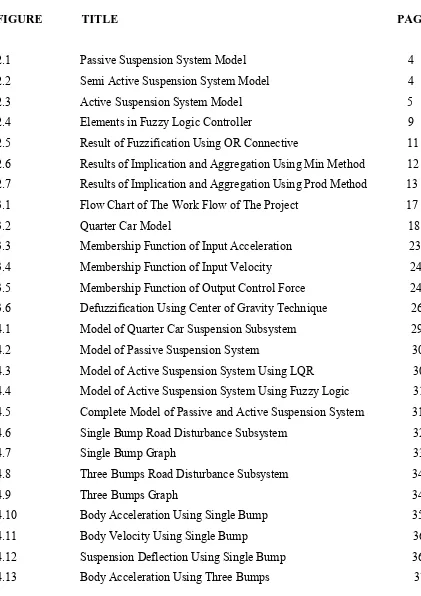UNIVERSITI TEKNIKAL MALAYSIA MELAKA
FACULTY OF ELECTRICAL ENGINEERING
FINAL YEAR PROJECT REPORT
Modeling And Controller Design For An Active Car Suspension System
Using Quarter Car Model
PREPARED BY:
MOHD SYAZWAN NAIM BIN MOHAMAD BASIR
B010810129
Bachelor Of Electrical Engineering
i
“ I hereby declare that I have read through this report entitle “ Modeling And Controller Design For An Active Car Suspension System Using Quarter Car Model” and found that it has comply the partial fulfillment for awarding the degree of Bachelor of Electrical Engineering (Control, Instrumentation and Automation)”
Signature :
Supervisor‟s Name : ARFAH SYAHIDA BINTI MOHD NOR
ii
MODELING AND CONTROLLER DESIGN FOR AN ACTIVE CAR SUSPENSION SYSTEM USING QUARTER CAR MODEL
MOHD SYAZWAN NAIM BIN MOHAMAD BASIR
A report submitted in partial fulfillment of the requirements for the degree
of Bachelor of Electrical Engineering (Control, Instrument and Automation)
Faculty of Electrical Engineering
UNIVERSITI TEKNIKAL MALAYSIA MELAKA
iii
I declare that this report entitle “Modeling And Controller Design For An Active Car Suspension System Using Quarter Car Model” is the result of my own research except as
cited in the references. The report has not been accepted for any degree and is not concurrently submitted in candidature of any other degree.
Signature :
Name : MOHD SYAZWAN NAIM BIN MOHAMAD BASIR
iv
v
ACKNOWLEDGEMENT
First and foremost, I would like to express my appreciation to my supervisor, Miss Arfah Syahida Binti Mohd Nor for the guidance and motivation throughout the progress of this project.
I also like to thank my parent, brothers and sister for always be there to support me all the time and give me the courage and strength that are necessary for me to carry on with this project. Thanks for their encouragement, love and emotional supports that they had given to me.
vi
ABSTRACT
vii
ABSTRAK
x 5.1 Conclusion 42
5.2 Future Suggestions 43
xi
LIST OF TABLES
TABLE TITLE PAGE
xiii
4.14 Body Velocity Using Three Bumps 38
4.15 Suspension Deflection Using Three Bumps 38
4.16 Body Acceleration Using = 335 kg 39
4.17 Body Velocity Using = 335 kg 40
xiv
LIST OF SYMBOLS
, , - Body displacement, wheel displacement, road displacement
, , - First order derivative of body displacement, wheel displacement, road displacement
1 of the past researches shows that the active suspension system can provide better riding comfort and improve the handling of the car. The purpose of this project is to design a Fuzzy Logic controller for an active car suspension by using the quarter car model. The performance Fuzzy Logic controller then will be compare with the Linear Quadratic Regulator (LQR) and the passive suspension system in term of its body acceleration, body velocity, and suspension deflection.
1.2 Problem Statement
2
1.3 Objectives
The objectives of this project are as follows:
i. To design a Fuzzy Logic Controller for an active car suspension system using quarter car model.
ii. To design the Linear Quadratic Regulator (LQR) controller and passive suspension system as the comparisons for the Fuzzy Logic Controller. iii. To analyze the performance of Fuzzy Logic Controller, LQR controller and
the passive car suspension system using computer simulation.
1.4 Scopes
To achieve the objectives of the project, there are several scopes that need to be followed:
i. This project will be focus on to design the Fuzzy Logic controller for the quarter active car suspension system.
ii. Analyze the performance of proposed Fuzzy Logic Controller, LQR controller and the passive car suspension system with different road profiles.
3
CHAPTER 2
LITERATURE REVIEW
2.1 Introduction
This chapter includes the studies and research paper that related to this project. The papers have been referred carefully since there are some knowledge and information from the papers that can be use and apply to complete this project. The literature review was a process that will be ongoing until the end of the project. The sources of the literature review are thesis, journals, reference books and others sources from the internet.
2.2 Literature Research
2.2.1 Type of Car Suspension
2.2.1.1 Passive Suspension System
4
Figure 2.1: Passive Suspension System Model
2.2.1.2 Semi-Active Suspension System
In the semi active suspension system, the conventional spring like the one in the passive suspension system is attached parallel with an active damper. The damping force of the active damper can be adjusted to suit with the operating condition [2].
5 2.2.1.3 Active Suspension System
The active suspension system currently is the most advanced suspension system in the world. This type of suspension has an ability to store, dissipate and provide energy to the system. The active suspension has an active element; a hydraulic or pneumatic actuator that installed parallel with the spring and the shock absorber or damper [1-3]. The active element generates the additional force to the system and suppresses the system responds to the changes of the road surface and condition which in turns increase the performance ride comfortable and handling of the car. To operate, the active suspension system required some sensors, an electronic control unit (ECU) or a controller, and power source to power up the actuator. These additional units had made the design of the active suspension system very complex and increased the cost to develop and build it.
Figure 2.3: Active Suspension System Model
2.2.2 Fuzzy Logic Controller
6
inputs which are the body acceleration, body velocity, body deflection and one input, which is the desire actuator force. The designed Fuzzy Logic controller had been compared with the PID controller. There were two type road conditions that used as the road disturbance input, the smooth road and the real road roughness. For the smooth road condition, the proposed Fuzzy Logic controller had given the reduction in percentage in body acceleration, suspension working space and dynamic tire load amplitudes less than the PID controller by 65%, 19.35% and 30.43% respectively. For the real road roughness condition, the proposed Fuzzy Logic controller also gives the percentage in the body suspension model to represent the whole suspension system of a car. The designed Fuzzy Logic controller was compared with the Linear Quadratic Gaussian (LQG) and the passive suspension system. For the Fuzzy Logic controller, the inputs are the body velocity and the body acceleration while the output of the Fuzzy Logic controller was the force of the actuator. There were 9 rules developed for the Fuzzy Logic with the linguistic labels of Negative, Zero and Positive. The performance of the Fuzzy Logic controller and the LQG were evaluated by comparing the responses of its sprung mass acceleration, tire deflection, and suspension deflection. The responses from the simulation showed that the Fuzzy Logic controller had reduced the sprung mass acceleration, tire deflection and the suspension deflection more compared to the LQG. The decreased of the responses showed the improved of the ride and handling performance of the car.
7
results, the Fuzzy Logic controller gave the better performance compared to LQR and passive suspension. The Fuzzy Logic controller greatly decreased the responses of suspension deflection, body acceleration and the wheel deflection. The decreased of these three responses mean the increased of the ride comfort and road handling.
2.2.3 Linear Quadratic Controller (LQR)
In the research done by Abu Bakar Adham Bin Hell Mee [1], the Linear Quadratic Regulator (LQR) had been designed for the active suspension system. The system uses the half car model. For the half car model, the interaction is between the car body and the wheels between both ends of the car body. The first interaction caused the vertical motion and the second interaction produced an angular motion. The active suspension system with the LQR controller was compared with the passive suspension system. The performance for both active suspension system and passive suspension system were compared in term of 3 parameters, the vertical body displacement, vertical wheel displacement and the body acceleration. From the simulation, the Fuzzy Logic had decreased the body acceleration and the vertical body displacement. The decreased of the body acceleration and the vertical body displacement will lead to the increased of the driving comfort and handling of the car. Meanwhile, the Fuzzy Logic controller had increased the vertical wheel displacement of the suspension system and this showed the increased of the tire to road contact and reduced the probability for the car to loss of control.
8 2.2.4 Proportional Integral Sliding Mode Controller (PISMC)
Yahya Md.Sam and Johari Halim Shah Bin Osman proposed a new method of modeling the active suspension system by using the half car model [7]. The Proportional Integral Sliding Mode Controller (PISMC) was designed to be used in the active car using the PISMC increased the wheel deflection of the active suspension system; mean that the increased of the tire to road contact. This increased the car handling and will avoid the car from skidding. Besides that, the body acceleration of the half car model was slightly reduced when using the PISMC. So, it improved the ride comfort and retaining the road handling of the car. For overall, the simulation results showed that the PISMC proved to be effective in controlling the vehicle suspension system.
2.3 The Theory of Fuzzy Logic Controller
2.3.1 Introduction
In 1965, the concept of the Fuzzy Logic was introduced by Lofti Zadeh, a professor at University of California [9]. This concept do not applied to the control systems until 1970‟s due to the limitation of the computer capability at that time. Fuzzy Logic is a problem-solving control system that can implement itself in the system like embedded micro-controller, networked and multi-channel PC.
The advantages of Fuzzy Logic Controller are [10]:
9 inference mechanism, rule-based and defuzzification interface [10]. The fuzzification interface is the element that converts the inputs of Fuzzy Logic Controller which are in real number into fuzzy value. The fuzzy inference mechanism is where the input data are process and the outputs are compute. A rule-based holds the knowledge in the form of a set of IF-THEN rules, of how best to control the system. Then, the outputs which are in the fuzzy value are converted into real-number by defuzzification interface. Figure 2.4 shows the elements in the Fuzzy Logic Controller [2].
Figure 2.4: Elements in Fuzzy Logic Controller
2.3.2 Rule-Based System



